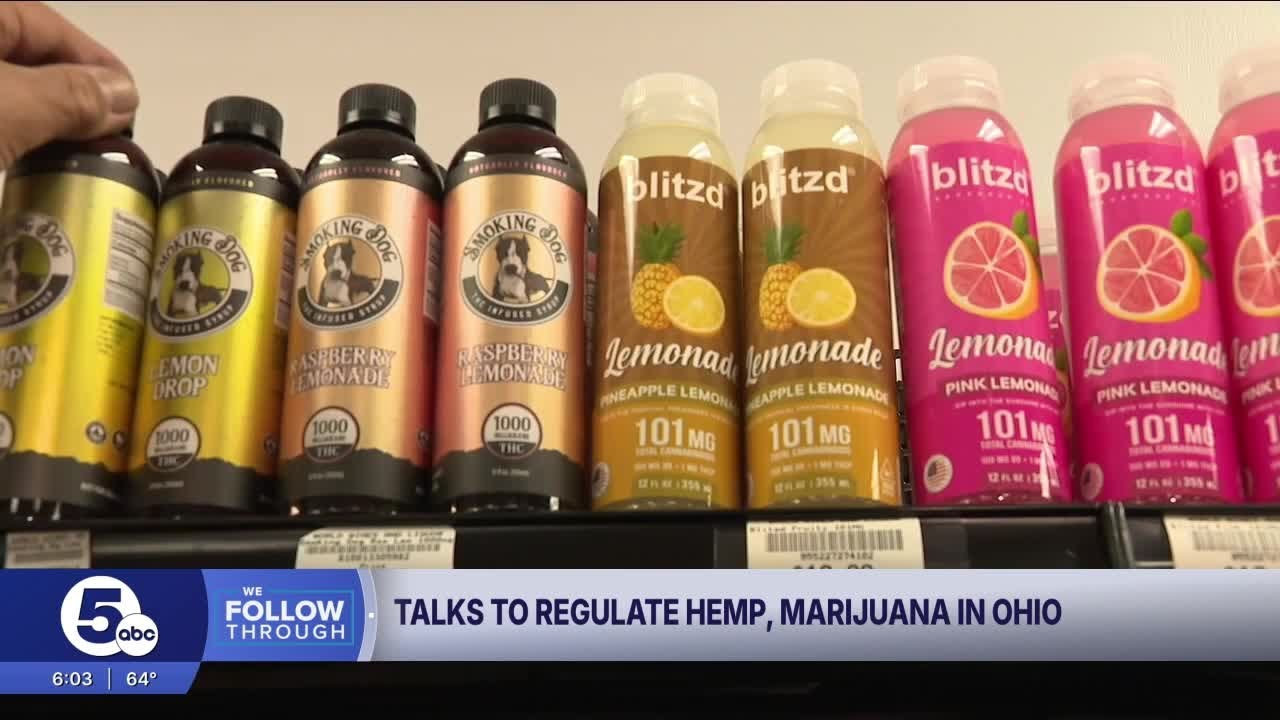Report on Ohio’s Legislative Revisions to Cannabis and Hemp Policy in Alignment with Sustainable Development Goals
Introduction: Legislative Context and Sustainable Development
The Ohio state legislature is currently reviewing Senate Bill 56, a proposal to amend the state’s voter-approved marijuana legalization framework. The revised legislation demonstrates a significant shift in focus towards the regulation of intoxicating hemp products, aligning with several key United Nations Sustainable Development Goals (SDGs). This report analyzes the proposed changes through the lens of SDG 3 (Good Health and Well-being), SDG 8 (Decent Work and Economic Growth), SDG 11 (Sustainable Cities and Communities), and SDG 16 (Peace, Justice, and Strong Institutions).
Legislative Framework and Institutional Governance (SDG 16)
The ongoing legislative process reflects the state’s efforts to build effective, accountable, and inclusive institutions by responding to a voter-approved initiative while addressing emergent public policy concerns.
Key Legislative Actions
- The Ohio House is set to amend Senate Bill 56, originally focused on restricting the recreational marijuana market.
- The revised focus will be on regulating intoxicating hemp-derived products, a measure previously attempted via an executive order that was subsequently blocked by the judiciary.
- This legislative maneuver, combining hemp and marijuana regulations, is a strategic effort to compel inter-chamber collaboration and achieve a comprehensive regulatory framework.
Institutional Dynamics
- Executive Branch: Governor Mike DeWine has urged legislative action, previously issuing an executive order to temporarily ban intoxicating hemp products, citing public health concerns.
- Legislative Branch: A divide exists within the majority party, with factions supporting regulated legalization, equal standing for hemp products, and outright prohibition. This highlights the challenge of building consensus in governance.
- Judicial Branch: The judiciary has played a crucial role by enjoining the governor’s executive order, ensuring that regulatory changes proceed through established legislative and legal channels.
Public Health and Well-being (SDG 3)
A primary driver of the legislative amendments is the protection of public health, particularly for youth, which is a core target of SDG 3.
Regulatory Measures for Public Health
- Youth Access Prevention: The bill aims to implement a temporary ban on high-THC content hemp products and introduce advertising restrictions to prevent marketing to minors.
- Controlled Product Availability: The proposal would permit the sale of THC beverages in regulated environments like stores and breweries while developing comprehensive rules for other consumable hemp products.
- Funding for Health Services: Discussions around the allocation of marijuana tax revenue include proposals to direct funds towards behavioral health services, directly supporting community well-being and mental health infrastructure.
Economic Growth and Sustainable Communities (SDG 8 & SDG 11)
The legislation carries significant implications for Ohio’s economic landscape, impacting both the nascent cannabis industry and the established hemp market, while also influencing the financial sustainability of local communities.
Economic Considerations
- Market Regulation and Impact: The hemp industry has expressed concern that the proposed regulations could severely restrict retail access, potentially limiting sales to a small number of licensed dispensaries and impacting small businesses like health food markets and CBD stores. This highlights the tension between regulation and fostering inclusive economic growth (SDG 8).
- Tax Revenue Allocation: A key component of the bill is ensuring tax revenue from adult-use cannabis sales is distributed to local governments as intended by the voter-approved initiative.
- Support for Local Communities: This allocation of funds is critical for supporting sustainable communities (SDG 11) by financing local public services. A recent university survey indicated that municipal leaders are unequivocally opposed to any proposals that would divert this promised funding.
Justice and Social Equity (SDG 16 & SDG 10)
The debate over cannabis reform intersects with goals for promoting just societies and reducing inequalities.
Provisions for Justice and Equity
- Criminal Justice Reform: Previous versions of the bill included provisions for new criminal penalties, which may be removed in the revised version. This aligns with efforts to create more just and equitable legal systems.
- Social Equity: The potential elimination of language that removed social equity provisions from the original legalization law is a critical consideration for reducing inequalities (SDG 10) within the new cannabis industry.
- Funding Public Safety: The governor has advocated for using a portion of tax revenue to support police training and local jails, linking the new market to the strengthening of justice institutions (SDG 16).
Analysis of Sustainable Development Goals in the Article
1. Which SDGs are addressed or connected to the issues highlighted in the article?
The article on Ohio’s marijuana and hemp legislation touches upon several Sustainable Development Goals (SDGs) by discussing public health, economic regulation, governance, and public finance. The primary SDGs identified are:
- SDG 3: Good Health and Well-being: This goal is relevant due to the focus on regulating intoxicating substances and protecting public health, particularly that of young people.
- SDG 8: Decent Work and Economic Growth: The article discusses the economic implications of the legislation on the hemp industry, including small businesses, which connects to fostering a sustainable and inclusive economy.
- SDG 16: Peace, Justice and Strong Institutions: The core of the article revolves around the legislative process, the functioning of state institutions, and the implementation of a voter-approved law, which are central themes of SDG 16.
- SDG 17: Partnerships for the Goals: The discussion on the allocation of tax revenue from cannabis sales to local governments and public services highlights the importance of domestic resource mobilization and partnerships between different levels of government.
2. What specific targets under those SDGs can be identified based on the article’s content?
Based on the article’s content, the following specific SDG targets can be identified:
- Target 3.5: Strengthen the prevention and treatment of substance abuse.
- The article directly addresses this target through the legislative effort to “refocus the proposal on regulating intoxicating hemp products” and implement provisions “aimed at preventing youth access to consumable hemp.” The introduction of “new advertising restrictions meant to prevent appealing to youth” is a specific measure to curb substance use among a vulnerable population. Furthermore, the governor’s proposal to “reallocate marijuana tax revenue to support… behavioral health services” aligns with the treatment aspect of this target.
- Target 8.3: Promote development-oriented policies that support… entrepreneurship… and encourage the formalization and growth of micro-, small- and medium-sized enterprises.
- The debate over the proposed legislation’s impact on the hemp market connects to this target. The U.S. Hemp Roundtable warns that the proposal could “severely restrict access to many hemp products now sold at retail” in places like “health food markets, groceries, and CBD stores,” which are often small or medium-sized enterprises. The legislative outcome will directly affect the business environment and growth potential for these companies.
- Target 16.6: Develop effective, accountable and transparent institutions at all levels.
- The article details the complex legislative process involving the Ohio House, Senate, and the Governor’s office as they attempt to amend a voter-approved law. The “months of back-and-forth” and internal party divisions illustrate the challenges in developing effective and accountable governance. The effort to ensure tax dollars are distributed “the way we had promised” and that “voters had promised” speaks directly to the principle of institutional accountability to the electorate.
- Target 17.1: Strengthen domestic resource mobilization… to improve domestic capacity for tax and other revenue collection.
- This target is addressed by the provisions concerning the allocation of tax revenue from marijuana sales. The article states that a key goal of the revised legislation is to ensure that “tax dollars from adult-use sales are distributed to local governments.” The governor’s separate push to “reallocate marijuana tax revenue to support police training, local jails and behavioral health services” is a clear example of mobilizing domestic financial resources to fund public services.
3. Are there any indicators mentioned or implied in the article that can be used to measure progress towards the identified targets?
Yes, the article mentions or implies several indicators that can be used to measure progress:
- For Target 3.5:
- Policy Implementation: The establishment of “advertising restrictions meant to prevent appealing to youth” and rules to “take the high-THC content stuff off the shelves” serve as policy-based indicators.
- Resource Allocation: The amount or percentage of marijuana tax revenue allocated to “behavioral health services” is a quantifiable financial indicator.
- For Target 8.3:
- Economic Activity: The article provides direct economic data that can serve as baseline indicators, such as “Ohio medical and adult-use marijuana sales officially crossed $3 billion” and the state “sold about $703 million in recreational cannabis in the law’s first year.” Future sales data can track the market’s growth or contraction.
- Business Impact: An implied indicator is the number of retail businesses (e.g., “health food markets, groceries, and CBD stores”) selling hemp products, which could be monitored to assess the impact of the new regulations on small enterprises.
- For Target 16.6:
- Legislative Output: The final version of the bill (SB 56) and its alignment with the original voter-approved initiative can be seen as an indicator of institutional responsiveness and effectiveness.
- Stakeholder Satisfaction: The survey from Ohio State University, which found that “local leaders were ‘unequivocally opposed’ to earlier proposals,” is an indicator of how well institutional decisions align with the interests of other public entities.
- For Target 17.1:
- Revenue Collection and Distribution: The primary indicator is the total “tax dollars from adult-use sales” collected and the specific amounts or percentages “distributed to local governments,” “police training,” and other public services.
4. Summary Table of SDGs, Targets, and Indicators
| SDGs | Targets | Indicators |
|---|---|---|
| SDG 3: Good Health and Well-being | 3.5: Strengthen the prevention and treatment of substance abuse. |
|
| SDG 8: Decent Work and Economic Growth | 8.3: Promote policies that support small- and medium-sized enterprises. |
|
| SDG 16: Peace, Justice and Strong Institutions | 16.6: Develop effective, accountable and transparent institutions. |
|
| SDG 17: Partnerships for the Goals | 17.1: Strengthen domestic resource mobilization. |
|
Source: marijuanamoment.net






